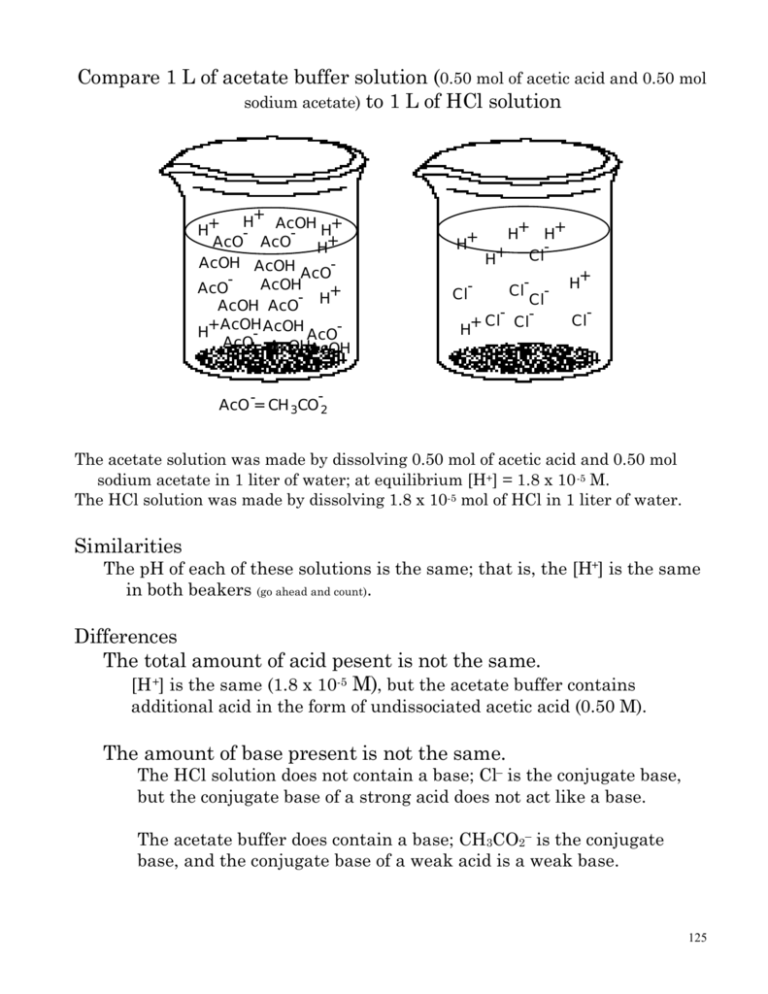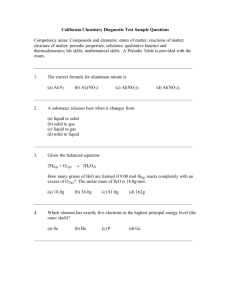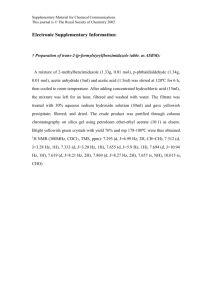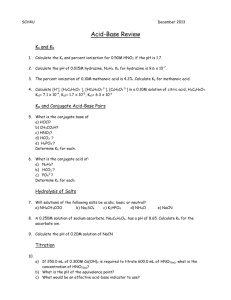Compare 1 L of acetate buffer solution (0.50 mol of acetic acid and
advertisement

Compare 1 L of acetate buffer solution (0.50 mol of acetic acid and 0.50 mol sodium acetate) to 1 L of HCl solution H+ AcOH + + H H AcO AcO H+ AcOH AcOH AcO AcOH AcO + AcOH AcO H H+ AcOH - AcOH AcO AcOHAcO AcOH H+ H+ H+ Cl H+ - Cl Cl ClH+ Cl - Cl H+ Cl - AcO -= CH 3CO 2 The acetate solution was made by dissolving 0.50 mol of acetic acid and 0.50 mol sodium acetate in 1 liter of water; at equilibrium [H+] = 1.8 x 10 -5 M. The HCl solution was made by dissolving 1.8 x 10-5 mol of HCl in 1 liter of water. Similarities The pH of each of these solutions is the same; that is, the [H+] is the same in both beakers (go ahead and count). Differences The total amount of acid pesent is not the same. [H +] is the same (1.8 x 10-5 M), but the acetate buffer contains additional acid in the form of undissociated acetic acid (0.50 M). The amount of base present is not the same. The HCl solution does not contain a base; Cl– is the conjugate base, but the conjugate base of a strong acid does not act like a base. The acetate buffer does contain a base; CH3CO2– is the conjugate base, and the conjugate base of a weak acid is a weak base. 125 What happens when base is added to each flask. Say, 0.001 mol NaOH. The following reaction occurs H+ (aq) + OH– (aq) H2O (l) So, the H+ is consumed by the OH–. start mol reaction after reaction H+ 0.000018 0.000018 0.000018 ~0 OH– 0.0010 0.0010 0.000018 9.82 x 10-4 H2O Since it is a 1 L soln [OH–] = 9.82 x 10–4 and find H+ by using Kw [H+] = 10-14 / 9.82 x 10–4 = 1.018 x 10-11 pH = 10.99 In the acetate flask the OH– consumes the free H+ and reacts with the H+ still bound to the acetic acid CH3CO 2H(aq) + OH– (aq) CH3CO 2– (aq) + H2 O(l) The concentration of acetic acid and acetate have both changed now start mol reaction after reaction CH3C(O)OH 0.50 0.50 - 0.0010 0.499 OH– 0.0010 0.0010 - 0.0010 ~0 the amounts above are moles CH3C(O)O– 0.50 0.50 + 0.0010 0.501 The concentrations of the H+, CH3CO2–, and CH3CO2H are no longer equilibrium concentrations. The equilibrium will now react to the change. 126 CH3CO 2H(aq) CH3CO 2– (aq) + H+ (aq) Switch from limiting reagent to equilirium problem... I C E CH3C(O)OH H+ CH3C(O)O– 0.499/1 -x 0.499/1 - x ~0 +x +x 0.501/1.01 +x 0.501/1.01 + x 1.8 x 10-5 = (0.501 + x)x (0.499 - x) x is small... 1.8 x 10-5 = (0.510)x (0.499) 1.8 x 10-5 = (0.510/0.499)x x = 1.79 x 10-5 [H+] = 1.79 x 10-5 pH = 4.75 In fact the [H+] = 1.79 x 10-5 so pH = 4.75. The [H+] concentration only decreased by 0.0000001 even though 0.001 mole OH– were added. The weak acid (acetic acid) restored most of the lost protons. What happens when more acid is added to each solution? Say 0.002 mol of HCl. 127 The HCl solution The [H+] = 1.8 x 10-5 mol + 0.002 mol = 0.002018 mol pH = – log (0.002018) = 2.70 The acetate solution Add HCl to the acetate buffer. CH3CO 2H(aq) CH3CO 2– (aq) + H+ (aq) The [H+] increases, but once the [H+] increases the reaction is no longer at equilibrium. So, the equilibrium reacts to consume the extra protons. The acetate consumes the H+. Treat this as a reaction of a strong acid with a weak base... CH3CO2– (aq) + H+ (aq) CH3CO 2H(aq) since K = 1/1.8 x 105, this is a reaction that goes to completion. start mol react after rxn CH3C(O)O– 0.50 - 0.0020 0.498 H+ 0.0020 - 0.0020 ~0 CH3C(O)OH 0.50 + 0.0020 0.502 CH3CO2-, a weak base, and CH3CO2H, a weak acid, are in solution. Further, [H+] is listed as approximately zero. To find what the [H+] is an equilibrium problem must be solved. CH3CO 2H(aq) init change CH3C(O)OH 0.502 -x CH3CO 2– (aq) + H+ (aq) H+ ~0 +x CH3C(O)O– 0.498 +x 128 equil 0.502 - x x 0.498 + x 1.8 x 10-5 = (x)(0.498 + x) (0.502 - x) small x approx x = 1.81 x 10-5 pH = 4.74 So, what makes a buffer? The presence of both a weak acid and the conjugate base. Is a solution of acetic acid a buffer? NO. A solution acetic acid does not contain much base. CH3CO 2H(aq) CH3CO 2– (aq) + H+ (aq) Ka = 1.8 x 10-5 Acetic acid does not dissociate much so the amount of H+ and CH3CO2– is small. Since the amount of acetate is small the solution cannot absorb any acid. –––––––––––––––––––––––––––––––––––––––––––––––––––––––– Is an acetate solution a buffer? No, there is nothing present to release protons. –––––––––––––––––––––––––––––––––––––––––––––––––––––––– Is a solution of NaCl and HCl a buffer? NO. An acid and a conjugate base are present...yeah, but it is a stong acid, and the conjugate base is not a base. HCl (aq) –––> H+(aq) + Cl–(aq) 129 HCl dissociates 100% so there is no acid in reserve; that means, if base is added H+ is consumed, and there is no undissociated acid present to replace the H+ that have been consumed. If H+ is added it remains free; Cl– is such a week base that it has no affinity for H+. –––––––––––––––––––––––––––––––––––––––––––––––––––––––– 0.50 mol acetic acid are dissolved in 1 L of water. 0.25 mol NaOH are added. Is the resulting solution a buffer? Yes! How is that a stong base and a weak acid is involved. Well if a strong base is added to the weak acid a reaction occurs. CH3CO2H(aq) + OH– (aq) ––> H2O + CH3CO2–(aq) CH3C(O)OH OH CH3C(O)O– start mol 0.50 0.25 ~0 reaction - 0.25 - 0.25 + 0.25 after rxn 0.25 ~0 0.25 See, there is a solution of a weak acid and a weak base. –––––––––––––––––––––––––––––––––––––––––––––––––––––––– How do you make a buffer with a certain pH? Well, pH is determined by [H+] For and acid HA at equilibrium Ka = [H+][A–] [HA] or [H+] = Ka[HA] [A–] if we start at an initial condition [HA]o and [A–]o then the [H+] = x 130 x = Ka ([HA]o - x) ([A–]o + x) Since Ka is small the reaction is not going to proceed very far, especially since both reactants and products are already present. So, x is small. [HA] = [HA]o - x ~ [HA]o So, and [A–] = [A–]o + x ~ [A–]o [H+] = Ka ([HA]o/[A–]o) so, the pH is determined by number of moles of and acid divided by the number of moles of the conjugate base present in solution. furthermore, since it is concetration divided by concentration let us take the –log of both sides –log[H+] = –log(Ka[HA]o/[A–]o) –log[H+] = –log(Ka) + –log([HA]o/[A–]o) or... pH = pKa – log([HA]o/[A–]o) pH = pKa + log([A–]o/[HA]o) –––––––––––––––––––––––––––––––––––––––––––––––––––––––– How would you make a buffer with a given pH...simple. 1. Pick the acid base system you want to use. •A buffer works best when there is an equal amount of acid and base present. •Pick an acid base system so that the pKa is close to the pH if [A–]/[HA] = 1 then this relationship 131 simplifies to pH = pKa + log([A–]o/[HA]o) pH = pKa if pKa is close to the desired pH then [A–]/[HA] will not have to be far from 1 2. Use the Henderson-Hasselbalch equation or the Ka expression to find the ratio of acid to base required to give the desired pH. If no special conditions have been stated then you have the answer. For example Prepare a buffer that has a pH of 3.50. 1. Check Ka / pKa table for acid that has a Ka close to 3.50 I found HNO2 has a pKa = 3.40 2. Henderson-Hasselbalch equation pH = pKa + log[NO2–]/[HNO3] 3.50 = 3.40 + log[NO2–]/[HNO3] 0.10 = log[NO2–]/[HNO3] 1.26 = [NO2–]/[HNO3] So, I could use 1 mol HNO2 and 1.26 mol NO2– (NaNO2 if it is available). If NaNO2 is not available how would I make the solution? I would start with 2.26 mol HNO2 and add 1.26 mol NaOH. Why? Because 132 HNO2 + NaOH ––> NaNO2 + H2O So, 1.26 mol NaOH consumes 1.26 mol HNO2 leaving 1 mol HNO2 and 1.26 mol NaNO2. HNO2 OH– NO2– init 2.26 mol 1.26 mol ~0 rxn – 1.26 – 1.26 + 1.26 after rxn 1 ~0 1.26 If any special conditions have been set forth you must now take them into account. For example concentration limits limit concentration of 1 species Prepare 1 L of the buffer above and the concentration of acid ([HNO2]) must be 2.0 M. so special condition says 1 L x 2.0 mol HNO2 = 2.0 mol HNO2 1L you know the ratio of acid to base NO2– /HNO2= 1.26 so amount of NO2– NO2– = 2.0•1.26 NO2– = 2.52 mol limit total concentration 133 Prepare 500 mL of the buffer and the total concentration of acid and base must be 2.0 M. so special condition says 0.50 L x 2.0 mol (HNO2 + Na+ + NO2–) = 1.0 mol (HNO2 + Na+ + NO2–) 1L you know the ratio of acid to base NO2– /HNO2= 1.26 1.26•HNO2 = NO2– or and since substitute NaNO2 ––> Na+(aq) + NO2–(aq) Na+ = NO2– 1.0 mol = HNO2 + 1.26•HNO2 + 1.26•HNO2 1 = 3.52 HNO2 HNO2 = 0.28 mol and NO2– = 0.36 mol The special conditions are always the hard part here. If you wanted to prepare an acetate buffer, pH = 4.69, you could prepare any of the following solutions a 1.0 M acetic acid, 0.90 M sodium acetate solution a 0.05 M acetic acid, 0.045 M sodium acetate solution a 0.02 M acetic acid, 0.018 M sodium acetate solution All these buffers have the same pH, but they are different... They have different capcities. 134 The first solution will absorb more acid or base than the others, and it will have the smallest change in pH when each solution absorbs the same amount of acid or base. Compare two acetate buffers H+ AcOH H+ AcOH + H + H + AcOH H H+ AcO AcO AcO -= CH 3CO 2 H+ AcOH + H+ H AcO- AcO- H+ AcOH AcOH AcOAcOAcOH - H+ AcOH AcO AcOH H+ AcOH AcO- AcOHAcO AcOH AcO -= CH 3CO-2 Both solutions contain the same [H+] because [H+] is controlled by ratio of acid to congugate base, and both solutions are 3 acetates for every 2 acetic acids. What is the pH of the solution? pH = pKa + log [CH3CO2–]/[CH3CO2H] pH = 4.74 + log(3/2) pH = 4.74 + 0.176 pH = 4.92 The solution on the right has more acetate present so it can absorb more protons. The solution on the right also has more acetic acid present so it can release more protons when a base is added. 135 The capacity of the solution on the right is higher. Translation: the solution on the right can absorb more acid or base with a smaller amount of change in pH than the solution on the left. The grand-daddy pain in the neck special case Prepare 500 mL of a buffer with a pH of 3.50 which will absorb 0.010 mol H+ with a pH change of 0.02 pH units. Dissect the problem...prepare buffer of certain pH translates to pick acid find appropriate acid base ratio... So we pick HNO2 because the pKa = 3.40 determine ratio of acid to base pH = pKa + log[NO2–]/[HNO2] 3.50 = 3.40 + log[NO2–]/[HNO2] 0.10 = log[NO2–]/[HNO2] 1.26 = [NO2–]/[HNO2] Now the hard part...pH change of 0.02 when 0.01 mol H+ are added translates to pH can drop to 3.48 after the solution has reacted with 0.01 mol H+. So, what does the solution look like after 0.01 mol H+ are added. What happens when H+ is added? NO2– reacts with H+ to make HNO2 HNO2 init HNO2 reaction + 0.01 after rxn HNO2 + 0.01 H+ 0.01 – 0.01 ~0 NO2– NO2– – 0.01 NO2– - 0.01 136 so after the acid has been added putting numbers in but since we know pH = pKa + log(NO2–/HNO2) 3.48 = 3.50 + log (NO2– - 0.01) (HNO2 + 0.01) 1.26 = [NO2–]/[HNO2] or 1.26•[HNO2] = [NO2–] 3.48 = 3.50 + log (1.26•HNO2 – 0.01) (HNO2 + 0.01) 0.02 = log (1.26•HNO2 – 0.01) (HNO2 + 0.01) 1.047 = (1.26•HNO2 – 0.01) (HNO2 + 0.01) 1.047•HNO2 + 0.001047 = 1.26•HNO2 – 0.01 -0.213 HNO2 = -0.011047 HNO2 = 0.052 mol (0.0519) NO2– = 0.065 mol 137 Remember when you do these problems if you add say 10 mL of a 0.2 M NaOH solution to 500 mL of a 1 M acetic acid 1 M acetate buffer solution the neutralization reaction is done in MOLES 0.002 mol NaOH reacts with 0.500 mol CH3CO2H leaving 0.498 mol CH3CO2H NaOH CH3CO2– start 0.50 0.0020 0.50 reaction – 0.0020 – 0.0020 + 0.0020 after rxn 0.498 ~0 0.502 The molarity is used when doing the equilibrium part of the reaction; the volume is 0.50 + 0.010 = 0.51 L. mol/L initial change equilibrium CH3CO2H 0.498/0.51 0.976 –x 0.976 - x H+ ~0 ~0 +x x CH3CO2– 0.502/0.51 0.984 +x 0.984 + x 1.8 x 10-5 = x(0.984 + x) (0.976 - x) 1.8 x 10-5 = x(0.984) (0.976) 1.8 x 10-5 = x(0.984) (0.976) 1.78 x 10-5 = x [H+] = 1.78 x 10-5 138








